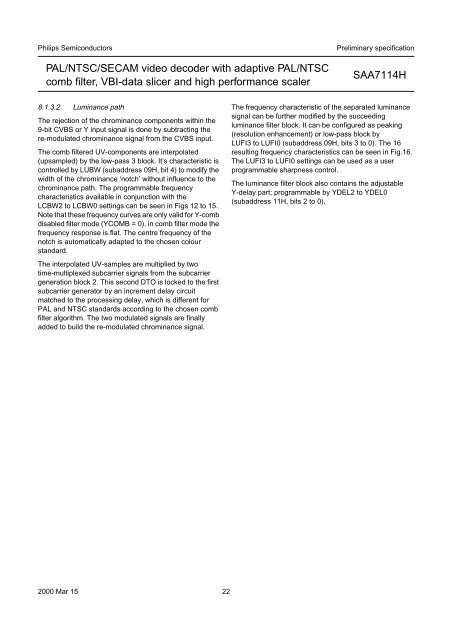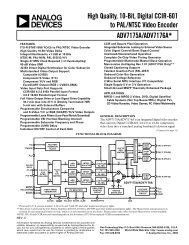PAL/NTSC/SECAM video decoder with adaptive PAL/NTSC comb ...
PAL/NTSC/SECAM video decoder with adaptive PAL/NTSC comb ...
PAL/NTSC/SECAM video decoder with adaptive PAL/NTSC comb ...
Create successful ePaper yourself
Turn your PDF publications into a flip-book with our unique Google optimized e-Paper software.
Philips Semiconductors<br />
<strong>PAL</strong>/<strong>NTSC</strong>/<strong>SECAM</strong> <strong>video</strong> <strong>decoder</strong> <strong>with</strong> <strong>adaptive</strong> <strong>PAL</strong>/<strong>NTSC</strong><br />
<strong>comb</strong> filter, VBI-data slicer and high performance scaler<br />
Preliminary specification<br />
SAA7114H<br />
8.1.3.2 Luminance path<br />
The rejection of the chrominance components <strong>with</strong>in the<br />
9-bit CVBS or Y input signal is done by subtracting the<br />
re-modulated chrominance signal from the CVBS input.<br />
The <strong>comb</strong> filtered UV-components are interpolated<br />
(upsampled) by the low-pass 3 block. It’s characteristic is<br />
controlled by LUBW (subaddress 09H, bit 4) to modify the<br />
width of the chrominance ‘notch’ <strong>with</strong>out influence to the<br />
chrominance path. The programmable frequency<br />
characteristics available in conjunction <strong>with</strong> the<br />
LCBW2 to LCBW0 settings can be seen in Figs 12 to 15.<br />
Note that these frequency curves are only valid for Y-<strong>comb</strong><br />
disabled filter mode (YCOMB = 0). in <strong>comb</strong> filter mode the<br />
frequency response is flat. The centre frequency of the<br />
notch is automatically adapted to the chosen colour<br />
standard.<br />
The interpolated UV-samples are multiplied by two<br />
time-multiplexed subcarrier signals from the subcarrier<br />
generation block 2. This second DTO is locked to the first<br />
subcarrier generator by an increment delay circuit<br />
matched to the processing delay, which is different for<br />
<strong>PAL</strong> and <strong>NTSC</strong> standards according to the chosen <strong>comb</strong><br />
filter algorithm. The two modulated signals are finally<br />
added to build the re-modulated chrominance signal.<br />
The frequency characteristic of the separated luminance<br />
signal can be further modified by the succeeding<br />
luminance filter block. It can be configured as peaking<br />
(resolution enhancement) or low-pass block by<br />
LUFI3 to LUFI0 (subaddress 09H, bits 3 to 0). The 16<br />
resulting frequency characteristics can be seen in Fig.16.<br />
The LUFI3 to LUFI0 settings can be used as a user<br />
programmable sharpness control.<br />
The luminance filter block also contains the adjustable<br />
Y-delay part; programmable by YDEL2 to YDEL0<br />
(subaddress 11H, bits 2 to 0).<br />
2000 Mar 15 22



